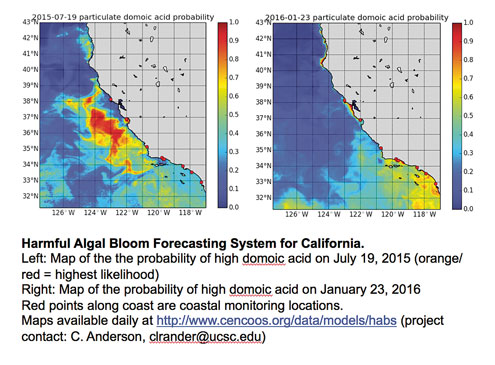Dr. Clarissa Anderson, Institute of Marine Sciences, UC Santa Cruz .

The closure of both the recreational and commercial Dungeness crab fishery this year in response to very high levels of the neurotoxin domoic acid (DA) in these animals is an unsurprising outcome of the massive harmful algal bloom (HAB) of the diatom Pseudo-nitzschia that took place from May to late September along the coast of California and all the way to Alaska. This bloom was tightly associated with the Pacific Warm Anomaly, or “blob,” of much higher than average water temperatures spreading throughout the North Pacific for the last two or more years. It appears as though the warm blob was sloshing up against the coast and creating perfect conditions for Pseudo-nitzschia, setting up a scenario where repeated strong pulses of upwelling were not strong enough to bring the very cold and nutrient-rich water to the phytoplankton at the surface, but rather moderate levels of nutrients. That set the stage for Pseudo-nitzschia to hold onto its dominance relative to other phytoplankton throughout the summer.
This year’s crab crisis has been unrelenting given the record-breaking levels of DA that were produced over a five-month long period. But then why did DA levels already fall in Santa Barbara and Ventura Counties and along the San Luis Obispo coast? We know DA was not as high this year in San Luis Obispo county as it was further north and much of what our predictive modeling efforts showed for Santa Barbara and Ventura Counties was high levels offshore, closer to the Channel Islands. Indeed, the Santa Cruz, Santa Rosa, and San Miguel Islands are still off limits to crab fishing, despite the re-opening of the fishery in the rest of the region.
As expected, California is now in the throngs of the continual storm systems that are the hallmark of El Niño along the southern portion of U.S. West Coast. Already, this El Niño is shaping up to be one of the top three on record with some similarities to the monstrous 1997/98 event. While the warmer than average sea surface temperatures off the coast this fall may have been attributable to an El Niño signature, it was somewhat difficult to differentiate the ocean warming from the warm blob. What is now more clear is that the strengthening and shifting of the subtropical jet stream by El Niño’s arrival over the North Pacific has been strong enough to diminish the influence of the “ridiculously resilient ridge” that prevented storm tracks from entering California.
El Niño appears to be winning out against the blob and leading to weather patterns that are not necessarily conducive to phytoplankton growth and bloom development. Pseudo-nitzschia is not entirely gone though, with cryptic populations resurging periodically, particularly during calm periods following storms when light levels allow for growth. It has not been prolonged enough or vigorous enough growth to lead to accompanying high rates of DA production. For this reason, there is hope that the residual pool of DA near the ocean sediments that has been intoxicating crabs and devastating fishermen will soon be depleted and perhaps mixed offshore.
A bigger question remains as to what the spring transition will bring now that there is an established “seeding” population of Pseudo-nitzschia that seems to be persisting off the coast. Will the anticipated decrease in nutrient conditions associated with typical El Niño’s be such that DA production is favored? Will it reach the incredible levels we saw in 2015 and be as pervasive or long-lived? Time will tell, and we are mobilizing resources to study this in greater detail as the dynamics evolve.